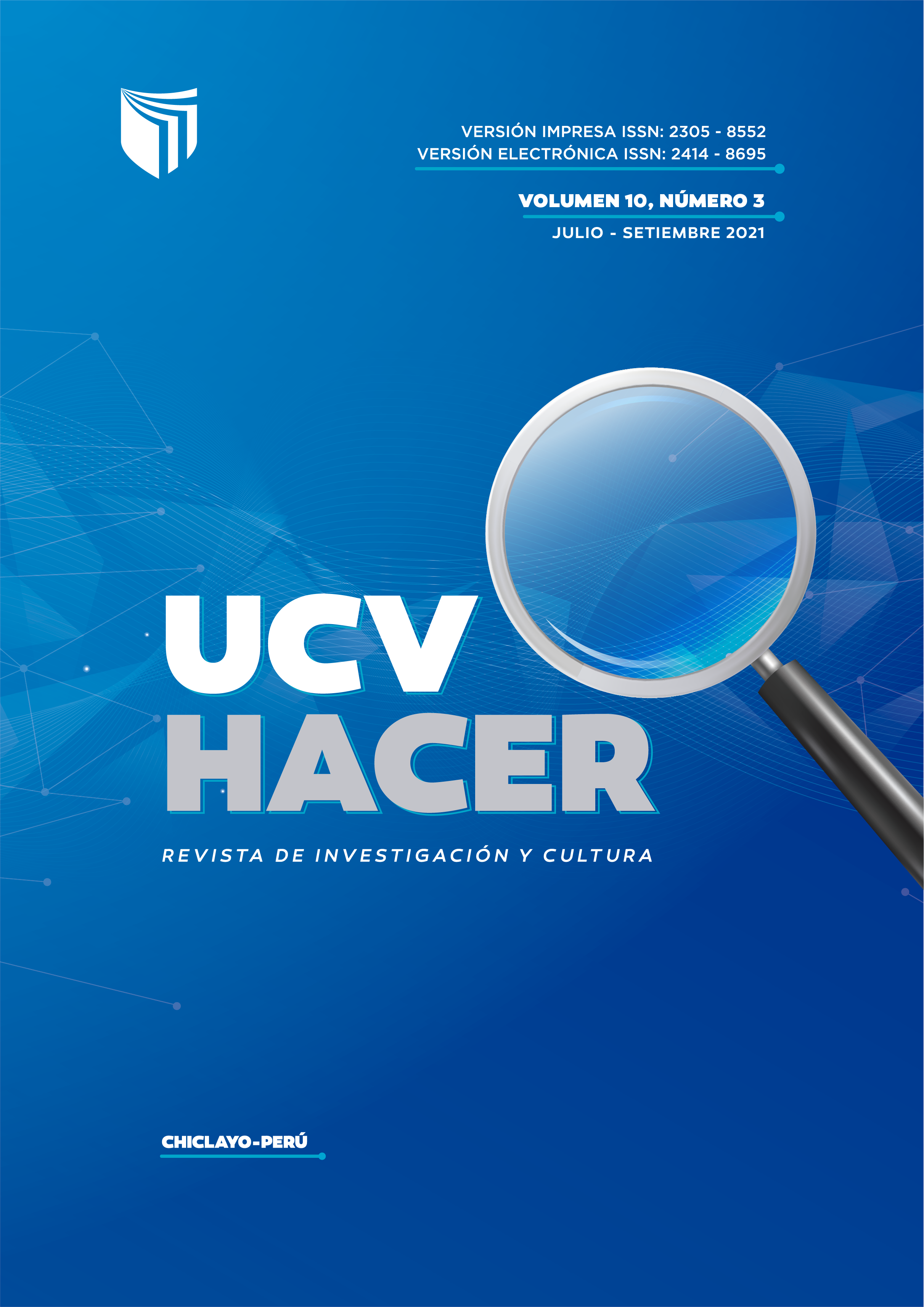Transformational leadership: a contribution to the motivation of the university student
DOI:
https://doi.org/10.18050/RevUCVHACER.v10n3a4Keywords:
Transformational leadership, Transactional leadership, Charismatic leadership, ResearchAbstract
The objective of the study, raises the perspective of the qualitative analysis of the theories that support and guide the behavior of individuals in their relationship with others to achieve goals, we examined the livelihoods of the different approaches to leadership theories transactional, charismatic, which sustain the dimensions of transformational leadership. The methodology based on: Search strategy was applied, the search for scientific documents began; item selection; Analysis of data. Achieving as a result, examining the livelihoods of the different approaches to theories, similarities were found between the behaviors of the leader with respect to his followers, in parallel, with the behavior of the teacher and the university student, having as a source of inspiration the investigation. Indeed, when examining the theories of transactional and charismatic leadership, to support transformational leadership, it had its corollary, in the description of the four dimensions of Burns (1978) and of the eight dimensions of Bennis and Nanus (1985), with which, it is concluded that it is these two theories that support the new actions of teachers in their goal of motivating their students in their foray into university research.
References
Avolio, B. J. (2007). Promoting more integrative strategies for leadership theory-building. The American Psychologist, 62(1), 25–33. https://psycnet.apa.org/doiLanding?doi=10.1037%2F0003-066X.62.1.25
Avolio, B. J., & Bass, B. M. (1995). Individual consideration viewed at multiple levels of analysis: A multi-level framework for examining the diffusion of leadership, 6(2), 199–218. https://www.sciencedirect.com/science/article/pii/1048984395900357
Bass, B. M. (1981). Stogdill ́s handbook of leadership. Nueva York: Free Press.
BASS, B. M. (1990). Bass & Stogdill’s Handbook of Leadership (3° ed.). New York: The Free Press.
Bass, B. M. (1990). Bass & Stodgill ́s handbook of leadership: Theory, research, and applications (3° ed.). Nueva York: The Free Press.
Bass, B. M., Avolio, B., Jung, D. y Berson, Y. (2003). Predicting unit performance by assessing transformational and transactional leadership. Journal of Applied Psychology. 88 (2), 207–218. http://dr-hatfield.com/Download/Leadership/apl882207.pdf
Bass, B. M., & Avolio, B. J. (1994). Improving Organizational Effectiveness through Transformational Leadership. Thousand Oaks, CA.: Sage Publications.
Bass, B. y Avolio, B. (2006). Manual for the multifactor leadership questionnare. Palo Alto. California, Estados Unidos: Consulting Psychologist Press.
Bass, B., & Riggio, R. (2006). Transformational leadership Mahwah. Erlbaum.
Bass, B.M. y Avolio, B.J. (1994). Improving organizational effectiveness through transformational leadership. Thousand Oaks: Sage.
Bass, B. (1985). Leadership and Performance Beyond Expectations. New York: Free Press.
Bass, B. (1996). Anew paradigm of leadership: An inquiry into transformational leadership. Alexandria, VA: U. S. Army Research Institute for the Behavioral and Social Sciences.
Bass, B. (1999). Two Decades of Re-search and Development in Transformational Leadership. European Journal of Work and Organizational Psychology, 8, 9-26. https://www.tandfonline.com/doi/abs/10.1080/135943299398410
Bass, B., y Avolio, B. (1990). Trans-formational Leadership development: Manual for the Multifactor Leadership Questionnaire. Palo Alto: Consulting Psychologists Press Inc.
Bennis, W. y Nanus, B. (2001). Líderes: Estrategias para un liderazgo eficaz. Barcelona, España: Editorial Paidos.
Bennis, W., & Nanus, B. (2008). Líderes. Estrategias para un liderazgo eficaz. Madrid: Paidós.
Burns, J. (2003). Transforming Leadership. New York, Estado Unidos: Grove Press.
Burns, J. M. (1978). Leadership. Nueva York: Harper & Row.
Casado, J. (2003). El valor de la persona: nuevos principios para la gestión del capital humano. Pearson Educación de Chile Ltda.
Cruz Ortiz, V. (2017). Liderazgo Transformacional: Estudios empíricos desde una perspectiva de grupos y de multinivel. https://www.tesisenred.net/handle/10803/405452
Dansereau, F., Graen, G.B., & Haga, W. (1975). A vertical dyad linkage approach to leadership in formal organizations. Organizational Behavior and Human Performance, 13(1), 46-78. https://www.sciencedirect.com/science/article/pii/0030507375900057
Díaz Castillo J. E. y Quiñones Lizárraga, A. J. (2018). Relación entre el liderazgo transformacional y la gestión educativa de una institución educativa parroquial, Florencia de Mora [Tesis de Maestría en Administración de la Educación. Escuela de Posgrado, Universidad Cesar Vallejo. Perú]. https://repositorio.ucv.edu.pe/handle/20.500.12692/11754
Drucker, P. (2002). Los Desafíos de la Gerencia del Siglo XXI. México: Norma.
Fernández, Guadalupe (2002). Talento Directivo: cómo medirlo y desarrollarlo. Pearson Educación, S.A., Madrid
Ganga, Francisco y Navarrete, Erwin. (2013). Enfoques asociados al liderazgo eficaz para la organización. Revista Gaceta Laboral. 19 (1), 52-77. https://www.redalyc.org/pdf/336/33626721007.pdf
Goldman, N. (1998). Los orígenes del federalismo rioplatense. Revolución, República y confederación. Sudamericana. Buenos Aires, 103-124.
González, O., González, O., Ríos, G., y León, J. (2013). Características del liderazgo transformacional presentes en un grupo de docentes universitarios. Telos. 15 (3), 355-371. https://www.redalyc.org/articulo.oa?id=99328424005
Graen, G.B., & Cashman, J. (1975). A role-making model of leadership in formal organizations: A developmental approach, In: J.G. Hunt & L.L. Larson (Eds.), Leadership Frontiers, 143-166. Kent, OH: Kent State University Press. https://www.researchgate.net/publication/245048689_A_Role-Making_Model_of_Leadership_in_Formal_Organizations_A_Developmental_Approach
Handy, Ch. (2006). El nuevo lenguaje de la labor de organización y sus consecuencias. El líder del futuro. Barcelona, España: Deusto.
Hellriegel, D. y Slocum, J. (2004). Comportamiento organizacional. México: Thomson Education.
Horn, A, y Marfán, J. (2010). Relación entre liderazgo educativo y desempeño escolar: Revisión de la Investigación en Chile. Psicoperspectivas. 9(2), 82-104. https://www.psicoperspectivas.cl/index.php/psicoperspectivas/article/view/116/143
House, R. (1977). A 1976 theory of charismatic leadership. En J.G. Hunt y L. L. Larson (Eds.), Leadership: The Cutting Edge, Carbondale: Southern Illinois University Press, 189-207. https://eric.ed.gov/?id=ED133827
House, R. y Shamir, B. (1993). Towards the integration of transformational, charismatic, and visionary theories. In M. M. Chemers & R. Ayman (Eds.), Leadership theory and research: perspectives and directions. San Diego, CA: Academic Press. https://psycnet.apa.org/record/1992-98503-004
House, R., Javidan, M., Hanges, P. y Dorfman, P. (2002). Understanding cultures and implicit leadership theories across the globe: an introduction to project GLOBE. Journal of World Business. 31(1), 3-10. https://www.sciencedirect.com/science/article/pii/S1090951601000694
Osorio Cáceres, J. C. (2017). El liderazgo transformacional como factor de mejoramiento de la calidad de la gestión de las Instituciones Educativas de la UGEL 07, San Borja, 2015 [ Tesis Doctorado en Ciencias de la Educación Lima –Perú`]. http://repositorio.une.edu.pe/handle/UNE/1678
Quea Larico, I.N. (2014). Liderazgo del director, su relación con el desempeño laboral de los profesores en el colegio adventista Túpac Amaru [Tesis de Magíster en Educación con mención en Administración Educativa, Ñaña, Lima, Perú]. https://repositorio.upeu.edu.pe/handle/20.500.12840/297
Robbins, S. (2009). Comportamiento Organizacional. Pearson Educación: México.
Downloads
Published
How to Cite
Issue
Section
License

This work is licensed under a Creative Commons Attribution-NonCommercial-ShareAlike 4.0 International License.










